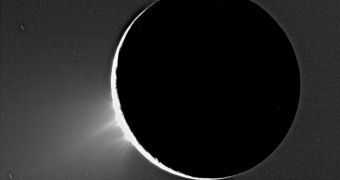Thanks to the most advanced space telescope ever built, researchers managed to establish that the influence the icy moon Enceladus exerts on Saturn is a lot more significant than originally thought. Apparently, the smaller body is the source of water vapors in the gas giant's atmosphere.
This was established by combining advanced computer models – based on discoveries made by the NASA Cassini orbiter – with readings collected this June by the Herschel Space Observatory. The latter was built and is managed by the European Space Agency (ESA).
Enceladus is already known for being extremely dynamic, for spewing water vapors and organic molecules through tiger stripe-like features at its south pole, and for potentially holding an ocean of liquid water under miles of granite-hard ice.
In more recent times, the moon was established to contribute ice, dust and gas to the gas giant's E Ring, explaining how material within regenerated. The new study suggests that some of the water vapors the object releases make their way into Saturn's upper atmosphere.
During its most recent observations session, Herschel was able to discover a massive torus – a donut-shaped cloud of sorts – of water created by Enceladus in its orbit around Saturn. The structure was about 37,000 miles (60,000 kilometers) thick and 373,000 miles (600,000 kilometers) across.
Even then, astronomers proposed that this cloud was the source of Saturn's water readings, but astronomers had no evidence to support their suggestion. Despite its massive size, the cloud is not visible in visible-light wavelengths, due to the fact that water is transparent.
“Herschel is providing dramatic new information about everything from planets in our own solar system to galaxies billions of light-years away,” explains NASA Herschel project scientist Paul Goldsmith, who is based at the agency's Jet Propulsion Laboratory (JPL), in Pasadena, California.
“What's amazing is that the model, which is one iteration in a long line of cloud models, was built without knowledge of the observation. Those of us in this small modeling community were using data from Cassini, Voyager and the Hubble telescope, along with established physics,” Tim Cassidy says.
“We weren't expecting such detailed 'images' of the torus, and the match between model and data was a wonderful surprise,” concludes the team member, a JPL postdoctoral researcher and a researcher at the University of Colorado in Boulder Laboratory for Atmospheric and Space Physics (LASP).

 14 DAY TRIAL //
14 DAY TRIAL //